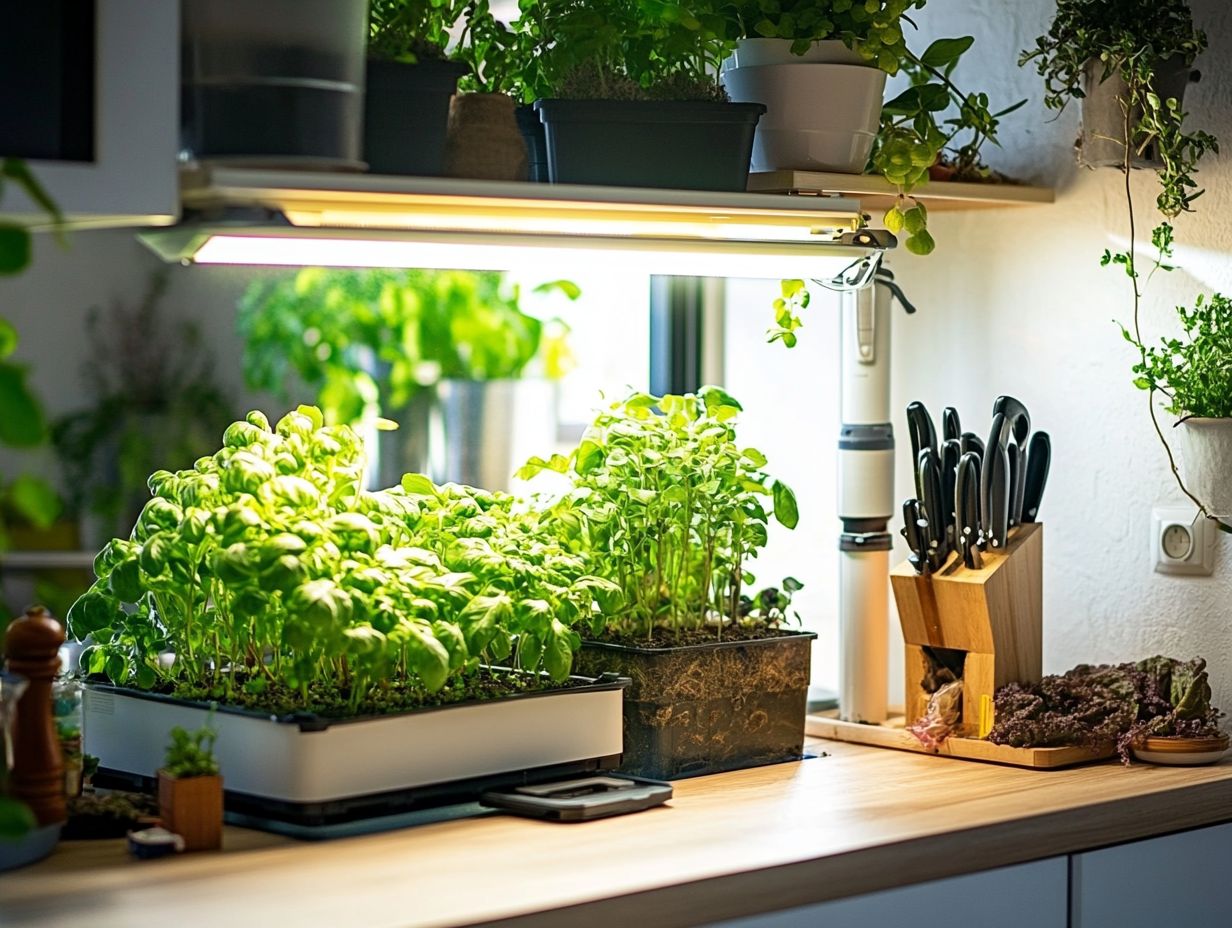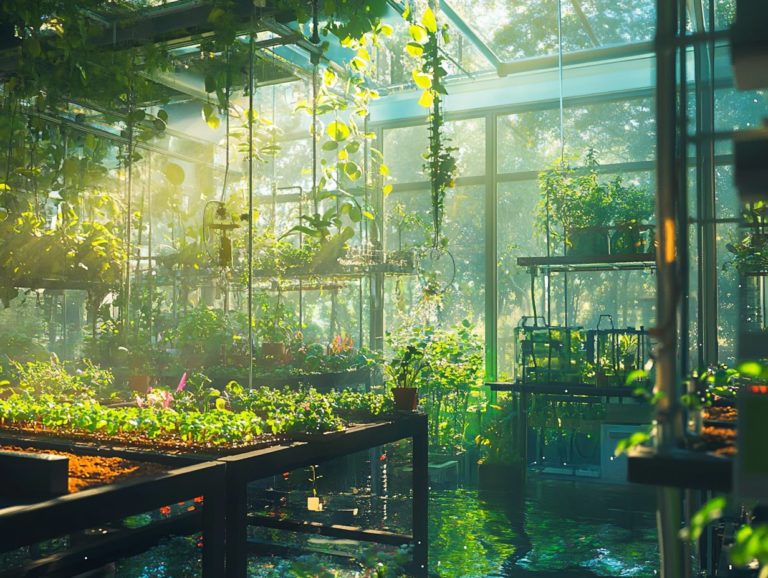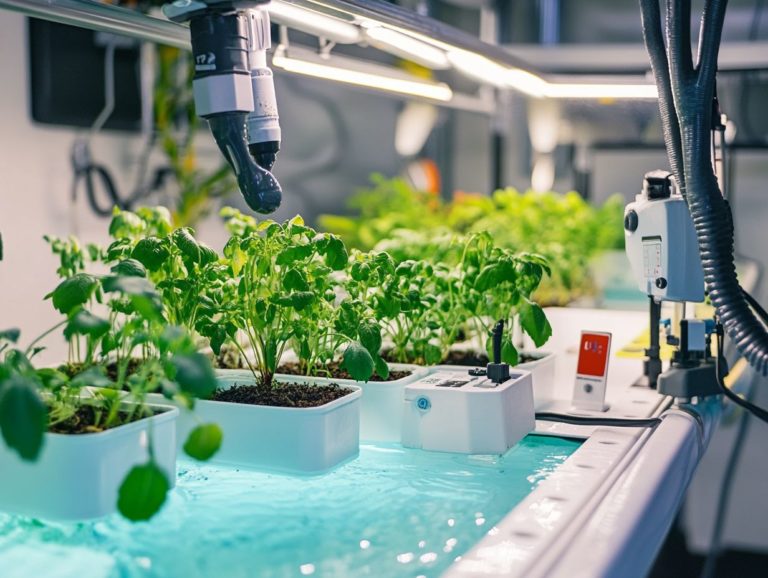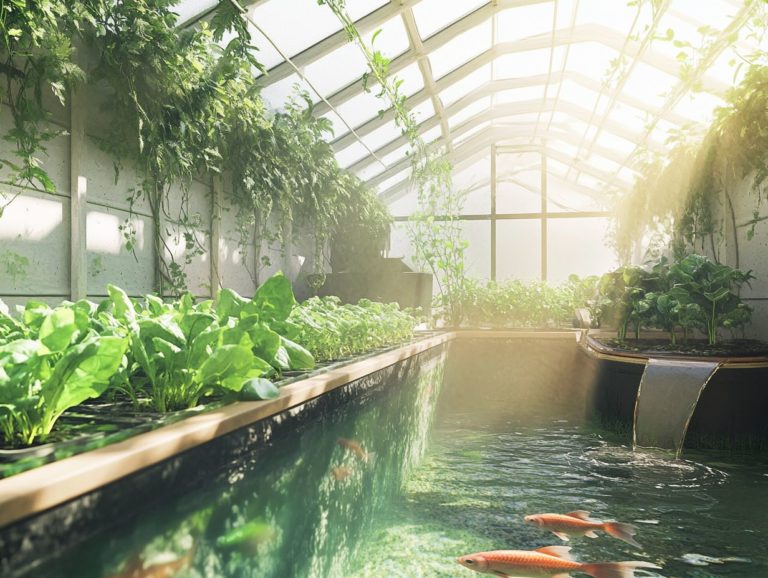Top Hydroponic Systems for Small Spaces
Are you envisioning a bountiful harvest of fresh herbs and vegetables, yet feel constrained by your limited space? Hydroponic systems offer a new way to grow a diverse array of plants without the need for traditional soil all within the cozy confines of smaller areas.
This article delves into the premier hydroponic systems specifically designed for compact living, ranging from vertical gardens to drip systems. It also provides vital tips on maximizing your yield, maintaining your setup, and steering clear of common pitfalls.
Explore how you can nurture your green thumb with various plant varieties, even in the tiniest of spaces!
Contents
- Key Takeaways:
- 1. Vertical Hydroponic Systems
- 2. Aeroponic Systems
- 3. Drip Systems
- 4. Ebb and Flow Systems
- 5. Nutrient Film Technique (NFT) Systems
- 6. Deep Water Culture (DWC) Systems
- 7. Wick Systems
- 8. Kratky Method
- 9. Dutch Bucket Systems
- 10. Tower Gardens
- 11. Window Farms
- 12. Hanging Gardens
- 13. Tabletop Systems
- 14. Container Systems
- 15. Choosing the Right Hydroponic System for Your Small Space
- What Are the Benefits of Using Hydroponic Systems in Small Spaces?
- What Are the Key Factors to Consider When Choosing a Hydroponic System for a Small Space?
- How Can One Maximize Space and Yield with a Small-Space Hydroponic System?
- What Are the Common Mistakes to Avoid When Setting Up a Hydroponic System in a Small Space?
- How Can One Maintain a Hydroponic System in a Small Space for Optimal Results?
- Frequently Asked Questions
Key Takeaways:

- Vertical hydroponic systems are ideal for small spaces as they utilize vertical space efficiently and can be easily customized for different plant types.
- Aeroponic systems require minimal maintenance and use minimal water, making them great for small spaces. They also allow for optimal oxygenation and nutrient delivery.
- Drip systems are a versatile and cost-effective option for small spaces, providing consistent watering and nutrients to plants in a controlled manner.
1. Vertical Hydroponic Systems
Vertical hydroponic systems offer a cutting-edge solution to indoor gardening, maximizing your space and efficiency. With these systems, you can grow various plants in water, completely bypassing the need for soil perfect for small spaces and urban living.
Made from high-quality materials, including durable plastic for water reservoirs, these systems ensure longevity and optimal water circulation for healthy plant growth. As more individuals embrace hydroponic gardening, understanding the unique designs and features of vertical systems becomes essential for anyone aspiring to cultivate a flourishing indoor garden.
By stacking plant trays vertically, these systems conserve valuable square footage and create a visually appealing setup that enhances modern interiors. They often come loaded with user-friendly features like built-in grow lights, timers, and self-watering mechanisms, making maintenance easy while providing an ideal environment for your plants.
Discover inspiring examples like the AeroGarden, which showcases how effectively these systems support plant nutrition by delivering precise amounts of nutrients directly to the roots. This results in faster growth and healthier yields. With the ability to grow a range of crops from herbs to leafy greens, these systems empower urban dwellers to engage in sustainable gardening practices, no matter their living arrangements.
2. Aeroponic Systems
Aeroponic systems are the pinnacle of modern hydroponics, offering an efficient way to grow plants by suspending them in air and misting their roots with a nutrient solution. This method enhances plant growth and boosts overall health.
With this innovative approach, you maximize oxygen uptake while minimizing water usage, making it an environmentally friendly choice that aligns with sustainable practices. One standout advantage of aeroponic systems over traditional hydroponic methods is their ability to promote faster growth rates and higher yields through optimal nutrient absorption.
You can cultivate a variety of plants in these conditions, including leafy greens, herbs, and even some fruit-bearing species, making them a versatile option for any aspiring gardener. The user-friendly design allows you to easily set up and maintain your systems, fostering a sense of accomplishment and enjoyment as you grow your own fresh produce.
Start your hydroponic journey today and transform your space into a vibrant indoor garden!
3. Drip Systems
Drip systems are an exceptional choice for your hydroponic gardening endeavors. With a network of tubes and emitters delivering a mix of water and nutrients directly to the roots of your plants, you ensure efficient water circulation and promote growth across various plant varieties, including herbs.
This precise delivery mechanism conserves water and significantly reduces nutrient waste, making it an environmentally friendly option. By allowing you to tailor your watering schedules, these systems foster robust root development, enabling your plants to thrive in limited spaces.
Whether you re a beginner or a pro, incorporating drip irrigation into your compact setups can yield impressive results without requiring extensive gardening infrastructure. It streamlines maintenance, allowing you to concentrate more on observing your plants health rather than constantly managing water levels, which makes gardening even more enjoyable.
4. Ebb and Flow Systems
Ebb and flow systems, often referred to as flood and drain systems, offer a remarkable approach to hydroponic gardening. They periodically flood your grow bed with a nutrient solution, allowing your plants to absorb essential nutrients before draining back into a reservoir. This process promotes robust growth for a wide range of plants.
This method gives your plants vital nutrients and prevents excess water, making it great for everyone. The advantages are plentiful: improved oxygenation of the root zone and the flexibility to customize nutrient delivery based on different growth stages.
You ll find that varieties like tomatoes, lettuce, and herbs thrive in these setups, relishing the consistent moisture and nutrient availability. Constructing an ebb and flow system is surprisingly straightforward, requiring only a few materials like a grow bed, a reservoir, and a simple timer to manage the flooding.
This makes it an accessible and rewarding option for anyone eager to delve into hydroponic methods.
5. Nutrient Film Technique (NFT) Systems
Nutrient Film Technique (NFT) systems offer a distinctive hydroponic method where a thin film of nutrient solution flows over the roots of plants. This ensures they receive essential nutrition while excess solution gracefully drains back into the reservoir.
This method maximizes space and speeds up growth, making it an enticing choice for hobbyists and commercial growers alike. By thoughtfully selecting crops that flourish in such conditions think leafy greens and herbs you can enjoy impressive yields.
Maintaining proper water circulation is crucial; it helps prevent root rot and guarantees that your plants receive just the right balance of moisture and nutrients. Regularly monitoring and adjusting pH levels, along with keeping the system clean, will significantly enhance the results of your NFT setup.
6. Deep Water Culture (DWC) Systems
Deep Water Culture (DWC) systems offer an exceptionally effective hydroponic method, allowing you to suspend plants in a nutrient-rich solution. This setup enables their roots to grow freely in water while benefiting from essential light exposure provided by strategically positioned grow lights, ultimately promoting vigorous plant growth.
This innovative technique creates an ideal environment for a variety of tropical and leafy greens, like lettuce, kale, and herbs, which flourish in this moist, nutrient-saturated setting. You ll find that the growing medium is often minimal, with the spotlight on the nutrient solution delivering essential minerals directly to the roots.
DWC systems offer great benefits: faster growth rates, increased yields, and reduced water usage make it an excellent choice, whether you’re a novice or a seasoned grower. To optimize your setup, ensure that your grow lights are positioned perfectly for maximum coverage, while keeping a close eye on water temperature and nutrient levels to help your plants grow strong.
7. Wick Systems

Wick systems stand out as one of the most straightforward and beginner-friendly types of hydroponics. By using a wick to draw nutrient solution from a reservoir to the plant roots, these systems are an ideal choice for anyone new to indoor gardening who desires an easy-to-use setup.
With no need for pumps or complex equipment, you can adopt a more hands-off approach to plant care. Wick systems flourish with a variety of plants, especially herbs like basil, mint, and parsley along with leafy greens such as lettuce and spinach. The constant moisture supply encourages robust growth while ensuring your plants receive essential nutrients without the risk of overwatering.
Thanks to their low maintenance requirements and simple configuration, novice gardeners often find these systems less intimidating. You can concentrate on enjoying the gardening experience rather than getting bogged down by technical challenges. Why not start your own wick system today and enjoy fresh herbs at home?
8. Kratky Method
The Kratky Method offers a great improvement in hydroponics, simplifying your growing experience by allowing plants to flourish in a static nutrient solution. This means your plants grow in water mixed with essential nutrients, without needing to change the water frequently. This technique is perfect if you’re seeking an easy indoor garden, especially for seed germination.
Imagine placing your plants in containers filled with nutrient-rich water, where their roots can freely access both water and air. It’s a recipe for healthy growth with minimal effort on your part. If you’re working with limited space, this method shines, requiring just basic materials like a container and a growing medium no complicated systems or fancy equipment needed.
Leafy greens such as lettuce, spinach, and basil thrive with this approach, offering a satisfying yield even from small setups. Its simplicity makes it an inviting entry point for beginners, allowing you to dive into the joys of gardening without feeling overwhelmed. Try the Kratky Method and watch your plants thrive!
9. Dutch Bucket Systems
Dutch bucket systems present an elegant solution in hydroponics. These systems feature individual buckets designed to cradle your plants while facilitating consistent water circulation. This ensures that each plant receives the essential nutrient solution and plant food required for optimal growth.
These systems are great for larger plants like tomatoes and cucumbers, offering ample space for root development while minimizing water wastage. Constructed from durable plastic, the buckets withstand wear and tear, enhancing longevity and making them a cost-effective choice for discerning growers.
To establish an efficient Dutch bucket system, consider the following steps:
- Set up a reliable pump for seamless water delivery.
- Employ a sturdy framework for adequate support.
- Implement a drainage system to prevent over-saturation.
Effective water management is paramount, as it helps maintain nutrient concentration and fosters healthy plant growth, ultimately leading to a more bountiful harvest. Start your own Dutch bucket system today and enjoy thriving plants!
10. Tower Gardens
Tower gardens offer you an innovative approach to hydroponics, allowing you to easily grow a variety of exciting plants in a vertical, space-saving design. This makes them an excellent choice for indoor gardening enthusiasts or anyone facing the challenge of limited space for a traditional garden.
These systems employ a soilless growing technique, delivering nutrients directly to the plant roots. It s an efficient and effective way for you to cultivate fresh herbs, vegetables, and even fruits. As an urban dweller, you can leverage this technology to maximize your growing potential, accommodating everything from compact leafy greens to vibrant strawberries, all within a confined footprint.
Having easy access to fresh produce can elevate your meal preparation experience. Plus, the compact design fits seamlessly into small spaces while adding a touch of aesthetic charm to your home decor, transforming indoor environments into lush, green sanctuaries. Why not give tower gardening a try and enjoy your homegrown produce?
11. Window Farms
Window farms offer you an innovative approach to indoor gardening by transforming your window space into a water-based garden that nurtures plant growth. This method is especially ideal for urban gardeners who prioritize sustainable practices.
These systems expertly harness natural light, ensuring your plants receive the energy they need for photosynthesis. They also remain conveniently accessible for care and harvesting. Typically, a window farm consists of a series of containers filled with nutrient-rich water, allowing roots to thrive without the need for soil. You can cultivate a variety of leafy greens, herbs, and small vegetables in these setups. Many users share their success stories of abundant harvests and vibrant colors right in their kitchens.
Many enthusiastic reviews highlight the delight of growing food at home. This is complemented by the ease of maintenance and the educational opportunities it provides for families. It s not just a practical endeavor; it s an enjoyable journey that enhances your living space.
12. Hanging Gardens
Hanging gardens present an innovative solution for hydroponics, allowing you to utilize vertical space effectively while crafting a stunning display of diverse plant varieties. This approach not only enhances the aesthetics of your environment but also maximizes space in compact areas.
By setting up a hanging garden, you can cultivate an impressive variety of plants. These include vibrant herbs like basil and mint, as well as eye-catching flowering specimens. The design often features a tiered structure or wall-mounted planters, ensuring that your plants thrive in well-drained soil with plenty of light.
This arrangement not only elevates the beauty of your space but also facilitates easy maintenance. Many systems are lightweight and straightforward to assemble. For urban dwellers and passionate gardening enthusiasts alike, creating these vertical gardens transforms a hobby into a smart, fulfilling way to make the most of limited space.
13. Tabletop Systems
Tabletop systems provide a sophisticated hydroponic solution for those eager to cultivate an indoor garden without sacrificing valuable space. They present an elegant, easy-to-use option for growing plants in various environments, from kitchens to offices.
Crafted with your convenience in mind, these systems harness nutrient-rich water to nourish your plants. This ensures they flourish even in compact areas. The advantages are plentiful: reduced maintenance and the delightful opportunity to grow fresh herbs like basil and mint, along with leafy greens such as lettuce and spinach ideal for culinary enthusiasts.
You ll love the user-friendly features in these tabletop systems! They include automated lighting and self-watering capabilities, making them incredibly accessible for beginners. This design allows novice gardeners like you to revel in the joy of successfully nurturing plants, all without the steep learning curve often associated with traditional gardening.
14. Container Systems

Container systems offer you a flexible and efficient approach to hydroponic gardening, allowing you to craft unique setups tailored perfectly to your space. This not only ensures optimal water circulation but also provides the essential nutrients that a variety of plants crave.
By employing such systems, you can significantly enhance both yield potential and plant health. The range of container options available includes plastic and fabric pots, each providing versatility in size and design. High-quality materials, such as food-grade plastic and breathable fabric, amplify aeration and drainage, fostering better root development.
You can also integrate features like drip irrigation systems to maintain consistent water circulation. This is vital for preventing root rot and nutrient deficiencies. For example, incorporating a sloped base within your containers can facilitate effective water movement, ensuring that every plant in your setup receives the nutrients necessary for robust growth.
Try setting up your own container system today and enjoy the benefits of efficient gardening!
15. Choosing the Right Hydroponic System for Your Small Space
Selecting the right hydroponic system for your small space can significantly elevate your indoor gardening experience. It allows you to make the most of the available area while opting for user-friendly systems that align with your gardening aspirations and the types of plants you wish to cultivate be it herbs, vegetables, or vibrant flowers.
As you weigh your options, it’s crucial to assess factors such as the dimensions of your indoor space, the complexity of the setup, and your specific crop preferences. For instance, compact systems like nutrient film technique (NFT) (a method where nutrients flow through a thin film of water) are an excellent choice for maximizing space while remaining straightforward to manage. If you’re just starting out, deep water culture (DWC) (a system where plants roots are submerged in nutrient-rich water) systems might be your best bet, as they require minimal technical expertise and upkeep.
Some hydroponic systems can facilitate rapid growth, particularly for leafy greens, while others excel with fruiting plants. Grasping these distinctions not only streamlines your decision-making process but also enhances the overall satisfaction of your gardening journey.
What Are the Benefits of Using Hydroponic Systems in Small Spaces?
Hydroponic systems bring a wealth of benefits to your small spaces. Imagine transforming your small space into a thriving garden! These systems allow you to maximize every inch while significantly boosting plant growth through optimized water circulation and nutrient delivery.
This approach conserves water using up to 90% less than traditional soil gardening but also opens the door to year-round cultivation of a diverse array of plants, from crisp leafy greens to fragrant herbs. Many gardeners revel in their ability to produce more food in a fraction of the space.
One enthusiastic hydroponic gardener shared how their small balcony now bursts with vibrant tomatoes and basil, forever changing their relationship with food production.
The versatility of these systems makes them an enticing option for you, whether you re looking to set up in a kitchen, basement, or patio. They offer a perfect blend of sustainability and satisfaction, ensuring your homegrown produce thrives even in limited outdoor areas.
What Are the Key Factors to Consider When Choosing a Hydroponic System for a Small Space?
When you re choosing a hydroponic system for a small space, it s crucial to weigh key factors like the available space, ease of use, and the types of plants you want to cultivate. This approach helps you garden successfully.
Budget considerations are also significant in determining the right setup. By evaluating both the initial costs and long-term maintenance expenses, you can make an informed decision that aligns with your financial plans.
For example, opting for a straightforward vertical tower system can be a game-changer. It uses minimal horizontal space and is budget-friendly, making it perfect for growing herbs like basil and cilantro. However, if you’re eager to grow larger plants, such as tomatoes or peppers, you might find that investing in a more robust deep water culture system is necessary, even if it comes with a higher price tag. To help you get started, check out this guide on the best hydroponic setup for beginners.
Lastly, don t overlook the importance of accessibility for maintenance and harvesting. This consideration will significantly enhance your enjoyment of hydroponic gardening, allowing you to savor the fruits of your labor with ease.
Why not start your indoor garden today and enjoy fresh produce at your fingertips?
How Can One Maximize Space and Yield with a Small-Space Hydroponic System?
Maximizing space and yield with a small-space hydroponic system is all about strategic planning and selecting compact setups. These setups make the most of every inch while providing ideal conditions for your plants to flourish. Utilizing plant nutrients effectively is crucial for optimal plant growth.
By incorporating vertical gardening techniques, you can tap into the vertical dimension of your space. This enables you to grow a greater number of plants without increasing your footprint. Choosing the right plant varieties those specially suited for hydroponics and known for their compact growth habits can significantly boost your productivity, especially when utilizing seed pods or seed plugs.
Don t underestimate the importance of proper lighting. Using energy-efficient LED grow lights can optimize plant health and enhance growth rates. Regularly monitoring nutrient levels and water pH is essential to ensure your plants thrive. This allows you to achieve higher yields while keeping them in tip-top shape.
What Are the Common Mistakes to Avoid When Setting Up a Hydroponic System in a Small Space?
Setting up a hydroponic system in a small space can indeed pose challenges. Steering clear of common pitfalls is essential for cultivating a thriving indoor garden. Key mistakes to avoid include neglecting proper plant nutrition, overcrowding, and insufficient light exposure.
As you embark on this indoor gardening adventure, it s important to pay attention to the unique needs of each plant. Ensure they receive the right nutrients in the right amounts. Overcrowding can create unhealthy competition for light and resources, so careful planning is paramount for a balanced arrangement.
Consider lighting systems designed for compact setups. They can transform a dim space into a vibrant oasis. User-friendly hydroponic systems like Gardyn and Click & Grow simplify the setup process. For those exploring options, understanding what types of hydroponic systems are best for home significantly reduces the chances of beginner mistakes and enhances your overall success.
Many of these systems come equipped with integrated grow lights and nutrient management tools, providing a seamless experience for anyone eager to cultivate fresh produce in a limited space.
How Can One Maintain a Hydroponic System in a Small Space for Optimal Results?
Maintaining a hydroponic system in a small space for optimal results requires regular attention to water levels, nutrient solutions, and effective water circulation. All of these are vital for supporting healthy plant growth. Choosing systems with a durable plastic water reservoir can help maintain the right environment.
It s imperative to routinely check pH levels to create an ideal environment that fosters nutrient absorption. Cleaning components like pumps and reservoirs is crucial in preventing harmful bacteria buildup and enhancing your system s efficiency. Consider investing in DIY products that are easy to use for maintenance.
Don t overlook the importance of monitoring light exposure. Your plants need the right balance of light for photosynthesis, which directly influences their growth and yield, especially when using LED grow lights. By consistently prioritizing these tasks, you ll witness flourishing plants that embody the rewarding benefits of a well-maintained hydroponic setup. Act now to keep your plants thriving!
Frequently Asked Questions

What are the top hydroponic systems for small spaces?
Some of the top hydroponic systems for small spaces include the Kratky method, vertical hydroponic towers, hydroponic kits, and drip systems.
Don t miss out on the chance to enjoy fresh produce! Start your hydroponic journey today.
What is the Kratky method?
The Kratky method is a simple hydroponic system that uses just one container for plants and nutrient solution. It s perfect for small spaces because it doesn t require electricity or pumps, making it one of the top picks for indoor gardening.
How does a vertical hydroponic tower work?
A vertical hydroponic tower stacks plants on top of each other. A pump sends nutrient solution from the bottom to the top, which helps you grow more plants in a smaller area, making it an ideal option for indoor smart gardens.
Are drip systems suitable for small spaces?
Yes! Drip systems can be customized for any size and shape. They use little water, making them ideal for indoor gardening. Many user reviews highlight their effectiveness in such environments.
What are the benefits of using hydroponic systems for small spaces?
Hydroponic systems enable year-round gardening and use less space and water than traditional gardening. They also yield more produce and can be used indoors, making them an exceptional choice for those interested in hydroponics.
Can hydroponic systems be used in apartments or small living spaces?
Absolutely! Hydroponic systems can fit on countertops, windowsills, or even walls. They provide fresh, homegrown produce right in your home without needing an outdoor garden, especially when using hydroponic setups that are easy to use.






